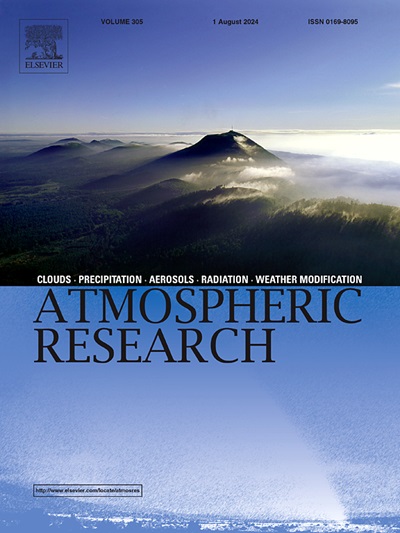Robust Typhoon Rainfall forecasting based on machine learning and Bayesian model averaging
IF 4.5
2区 地球科学
Q1 METEOROLOGY & ATMOSPHERIC SCIENCES
引用次数: 0
Abstract
Typhoon-induced heavy rainfall can lead to severe flooding, causing significant damage to social systems. Although machine learning (ML) offers an efficient approach for typhoon rainfall forecasting, individual models often exhibit considerable uncertainty. To address this, this study proposes a robust typhoon rainfall forecasting model based on Bayesian Model Averaging (BMA) with four ML models including Random Forest (RF), Support Vector Regression (SVR), K-Nearest Neighbors Regression (KNN), and eXtreme Gradient Boosting (XGBoost) across 0–6 h lead time. The model incorporates three types of features within the typhoon impact area (radius of 400 km): typhoon characteristics, grid spatial attributes and meteorological characteristics. Typhoon characteristics of each grid are dynamically weighted to reflect the weakening typhoon impacts with increasing distance from the typhoon center. Based on these features, multiple scenarios consisting of two experiments (Input Unchanged (IU) and Rolling Forecast (RO)) paired with various input designs (ALL: all features, SHAP3: 3 most critical variables, and LAG4: 4 lagged rainfall) are designed to explore the performance of all models. Case study of 28 typhoons affecting Guangdong Province from 2020 to 2023 clearly demonstrated that the weighted typhoon wind speed contributed the most in typhoon rainfall forecasting, and the BMA approach significantly enhanced the forecast accuracy. Leveraging sufficient effective information as model inputs could significantly improve the predictive performance of individual models in long-term forecasting. This method could provide flexible and suitable scenario options for data-rich and data-scarce regions, supporting early disaster warning during typhoon-prone seasons.
基于机器学习和贝叶斯模型平均的稳健台风降雨预报
台风引发的强降雨可能导致严重的洪水,对社会系统造成重大破坏。虽然机器学习(ML)为台风降雨预测提供了一种有效的方法,但单个模型往往表现出相当大的不确定性。为了解决这个问题,本研究提出了一个基于贝叶斯模型平均(BMA)的稳健台风降雨预测模型,该模型包括随机森林(RF)、支持向量回归(SVR)、k -近邻回归(KNN)和极端梯度增强(XGBoost) 4种ML模型,预测时间为0-6 h。模型在台风影响区域(半径400 km)内纳入了台风特征、网格空间属性和气象特征三类特征。对各网格的台风特征进行动态加权,以反映台风影响随离台风中心距离的增加而减弱。基于这些特征,设计了由两个实验(输入不变(IU)和滚动预测(RO))和各种输入设计(ALL:所有特征,SHAP3: 3个最关键变量,LAG4: 4个滞后降雨)组成的多个场景来探索所有模型的性能。对2020 - 2023年广东28个台风的实例分析表明,加权台风风速对台风降水预报的贡献最大,BMA方法显著提高了预报精度。利用足够的有效信息作为模型输入,可以显著提高单个模型在长期预测中的预测性能。这种方法可以为数据丰富和数据稀缺的地区提供灵活和合适的情景选择,支持台风多发季节的早期灾害预警。
本文章由计算机程序翻译,如有差异,请以英文原文为准。
求助全文
约1分钟内获得全文
求助全文
来源期刊

Atmospheric Research
地学-气象与大气科学
CiteScore
9.40
自引率
10.90%
发文量
460
审稿时长
47 days
期刊介绍:
The journal publishes scientific papers (research papers, review articles, letters and notes) dealing with the part of the atmosphere where meteorological events occur. Attention is given to all processes extending from the earth surface to the tropopause, but special emphasis continues to be devoted to the physics of clouds, mesoscale meteorology and air pollution, i.e. atmospheric aerosols; microphysical processes; cloud dynamics and thermodynamics; numerical simulation, climatology, climate change and weather modification.
 求助内容:
求助内容: 应助结果提醒方式:
应助结果提醒方式:


